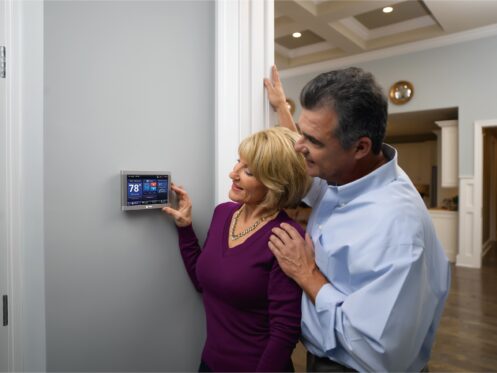Thermostats play an important role in HVAC systems by controlling our home’s temperature and keeping us cozy. When your thermostat acts up, it can make your home too hot or cold. This not only makes us uncomfortable but also wastes energy and money. Let’s explore easy ways to keep your thermostat and HVAC system working smoothly without breaking the bank.
Improper Placement of the Thermostat
In traditional homes, where you place your thermostat matters. It’s best to avoid sunny spots or drafty areas that can mess with your thermostat’s readings. Instead, go for a central spot away from windows or heaters. This way, your thermostat can accurately keep track of your home’s temperature and ensure your heating and cooling system works just right.
Wrong Temperature Readings on the Thermostat
To check if your thermostat shows the right temperature, place a separate thermometer close to the thermostat. You can also adjust your thermostat to a specific temperature and see if it matches the reading. Possible reasons for incorrect temperature readings include faulty sensors within the thermostat, improper placement near drafts or heat sources, and calibration issues.
Lack of Power to the Thermostat
If your thermostat doesn’t have power, your HVAC system won’t work right. Remember to check the batteries or power source often to keep your thermostat running smoothly. If you have power problems, try changing the batteries or checking the circuit breaker or fuse box to fix it. Before you start, turn off the power to your HVAC system at the circuit breaker to ensure safety.
Improper Thermostat Settings
Do you find your thermostat settings confusing? Let’s make them easier to understand with this simple guide:
- Cool setting: Use when you want to lower the temperature inside your home during warmer months, typically during spring and summer.
- Heat setting: Use when you need to raise the temperature inside your home during colder months, usually in fall and winter.
- Auto fan setting: This option allows the thermostat to automatically turn the fan on or off when needed for heating or cooling.
Sometimes, it’s not the thermostat that’s the problem but how we set it up. Let’s look at some common mistakes:
- Selecting the wrong mode: Users might accidentally set the thermostat to the wrong temperature for the weather, making it too hot or cold indoors.
- “Auto” vs. “on” fan settings: Use “auto” to save energy and maintain comfort. Use “on” if you need continuous airflow or air filtration.
- Temperature setting: Many thermostats offer features to adjust temperatures automatically. Not programming the temperature based on the time of day or occupancy can lead to discomfort and wasted energy.
By avoiding these errors, you can ensure your thermostat works efficiently to keep your home comfortable.
Choose Service Professor For Thermostat Services In Michigan
Upgrading to a smart thermostat has many benefits, like saving energy and making it easier to control your home’s temperature. Upgrading can also help improve your HVAC system’s efficiency and make your life more convenient.
When choosing smart thermostats, consider Service Professor, a trusted provider in Central/West Michigan since 1978. Our team is comprised of licensed, insured, and background-checked technicians.
We also offer upfront pricing and unparalleled customer service. With financing options, upgrading to smart thermostats for improved HVAC efficiency and comfort is easy.
Ready to make your home comfier? Contact Service Professor now to upgrade your thermostat and enjoy a smarter, more efficient HVAC system.

